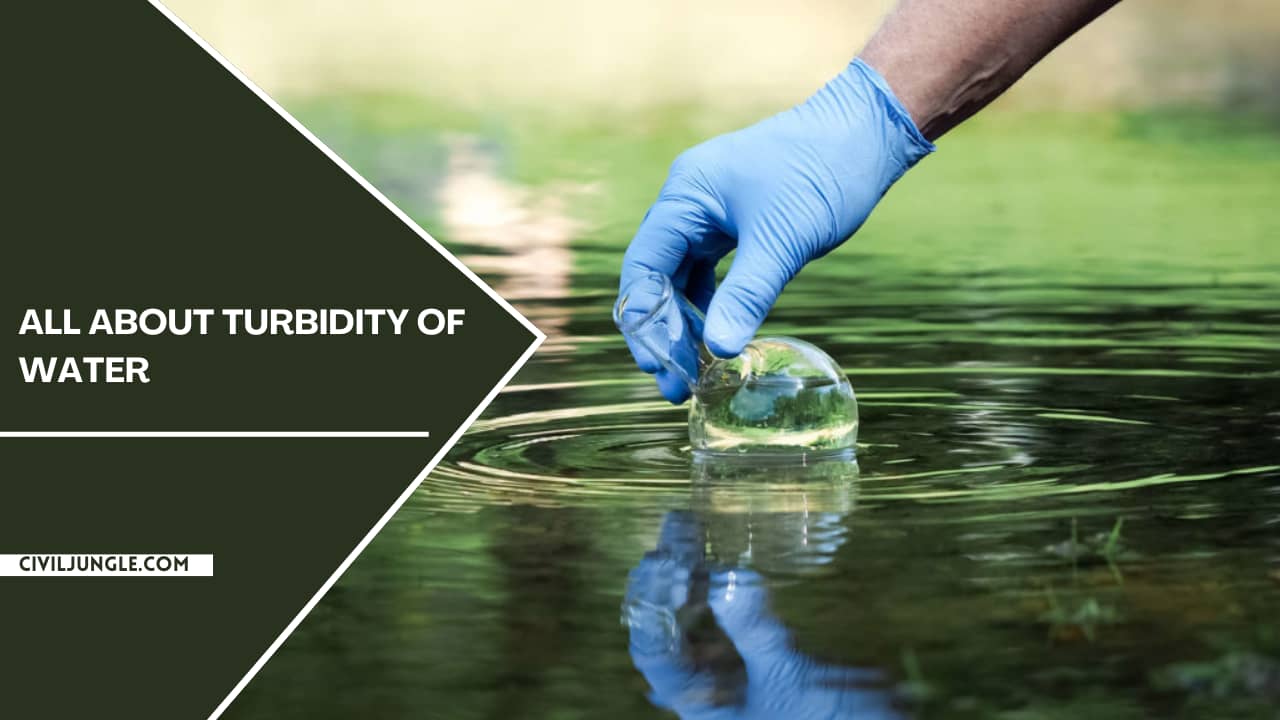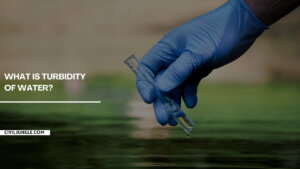What Is Turbidity of Water?
Important Point
Turbidity of water is a property of water or liquid by which we can measure the relative clarity of a liquid. The turbidity of water is an optical characteristic of liquid and is a measurement of light reflected through the materials, which are present in the water.
In simple words we can say that turbidity is a determining technique of haziness or cloudiness presence in a water sample.
By this technique we can determine the difference between muddy river water vs tap water.
When we examine the waters we can see the muddy water is brown color and presence high turbidity, on the other hand in tap water is colorless and it has very low turbidity.
Turbidity of Water Test
When water contains material of suspense inside it, then it is called turbide water. The turbid is generally made of algae or other organic material, which is measured when the visible materials are suspended in water.
The turbide is a part of clay or silt. The character and amount of turbidity depend on two factors, one is velocity of water and another is the type of soil on which the water flows. The procedure of turbidity of water test is described below –
Apparatus-
- For the turbidity of water test many types of apparatus are need that are, nephelo turbidity meter, beakers, glass tubes etc.
Procedure of Turbidity of Water Test
Here, we are going for a water turbidity test. We have divided this test into two parts as follows and let us know in detail.
1. Calibration of Nephelometer
- At first, we have to select the correct range of NTU on the nephelometer.
- After that, we have to fill distilled water on a test tube and set the nephelometer at a zero reading by a knob which is provided for zero setting.
- Next 40 NTU of standard solution is poured in the test tube and set the nephelometer reading at 40 NTU by using a calibration
knob.
2. Determination of Turbidity of Sample Water
- Before analysis it should keep in mind the sample temperature must come at room temperature.
- After this, we have to mix the sample thoroughly to the disperse solid and wait until the bubbles are out of the mixture.
- After removing the bubbles from the mixture we have to pour the water into the test tube.
- If the turbidity is more than 100 NTU, use a cell rise to get the turbidity duration factor.
- After doing the above actions we can see the turbine value on the turbidity meter and note down the value.
Application of Turbidity of Water Test Data
There are have many types of applications of turbidity of water test data, that are below
- The turbidity test is one of the most important tests of water for a water supply because by this test we can know which treatment and how is best for those water.
- By estimating the turbidity of filtered water we can find if there is any fault in the filter.
- By measurement of wastewater turbidity, we can know how the quantity of suspended solid water should be removed from the water.
- From the turbidity information, we can know how more doses and chemicals should me added for filter the supply water.
Turbidity
Turbidity is the cloudiness or haziness of a fluid caused by large numbers of individual particles that are generally invisible to the naked eye, similar to smoke in air. The measurement of turbidity is a key test of water quality.
Turbidity of Water
Turbidity is the measure of relative clarity of a liquid. It is an optical characteristic of water and is a measurement of the amount of light that is scattered by material in the water when a light is shined through the water sample. The higher the intensity of scattered light, the higher the turbidity.
What Is a Turbidity Meter?
Turbidity meters measure the amount of light scattered at a specific angle, and convert that reading into a turbidity measurement. Some turbidimeters are designed to compensate for color absorption and high turbidities, while others are intended for precise and accurate readings at very low turbidity levels.
Turbidity Meter
Turbidity meters are water-quality meters that measure the amount of suspended solid particles in water. They give readings as numeric values in nephelometric turbidity units (NTU) or formazin turbidity units (FTU) that indicate how turbid (cloudy) water is. The higher the number, the greater the turbidity.
NTU Turbidity
NTU stands for Nephelometric Turbidity unit, i.e. the unit used to measure the turbidity of a fluid or the presence of suspended particles in water. The higher the concentration of suspended solids in the water is, the dirtier it looks and the higher the turbidity is.
Turbidity Sensor
Turbidity sensors measure the amount of light that is scattered by the suspended solids in water. As the amount of total suspended solids (TSS) in water increases, the water’s turbidity level (and cloudiness or haziness) increases.
High Turbidity Water Treatment
Often, the waters from surface water resources have a high level of turbidity and need to be treated with flocculation/coagulation to remove the turbidity. Many flocculants and coagulants are widely used in conventional water treatment processes.
Turbidity in Water Treatment
Turbidity can act as a shield to pathogens and the particles that cause turbidity can harbor bacteria and viruses. Turbidity is removed through our multi-barrier water treatment process which includes coagulation, flocculation, sedimentation, filtration, and disinfection.
How to Measure Turbidity of Water?
The best way to measure turbidity in a wide variety of samples is with a nephelometer, also known as a turbidity meter. Turbidity meters utilize a light and photo detector to measure light scatter, and read out in units of turbidity, such as nephelometric turbidity units (NTU) or formazin turbidity units (FTU).
Turbidity Levels in Drinking Water
Turbidity: At no time can turbidity (cloudiness of water) go above 5 nephelolometric turbidity units (NTU); systems that filter must ensure that the turbidity go no higher than 1 NTU (0.5 NTU for conventional or direct filtration) in at least 95% of the daily samples for any two consecutive months.
How to Measure Turbidity?
The best way to measure turbidity in a wide variety of samples is with a nephelometer, also known as a turbidity meter. Turbidity meters utilize a light and photo detector to measure light scatter, and read out in units of turbidity, such as nephelometric turbidity units (NTU) or formazin turbidity units (FTU).
How to Measure Turbidity in Water at Home?
The simplest and lowest cost way to measure the turbidity of a sample is a turbidity tube. This is a tube with a black cross at the bottom and the user simply keeps pouring water into the tube until they can no longer make out the black cross at which point you can read off the scale on the outside of the tube in NTU.
Turbidity Levels in Drinking Water
At no time can turbidity (cloudiness of water) go above 5 nephelolometric turbidity units (NTU); systems that filter must ensure that the turbidity go no higher than 1 NTU (0.5 NTU for conventional or direct filtration) in at least 95% of the daily samples for any two consecutive months.
High Turbidity in Drinking Water
High turbidity in drinking water can shield bacteria or other organisms so that chlorine cannot disinfect the water as effectively. Some organisms found in water with high turbidity can cause symptoms such as nausea, cramps, and headaches.
Turbid Sample
Turbidity is the measure of relative clarity of a liquid. It is an optical characteristic of water and is a measurement of the amount of light that is scattered by material in the water when a light is shined through the water sample. The higher the intensity of scattered light, the higher the turbidity.
Jackson Turbidity Unit
Turbidity and Nephelometry
In nephelometry the intensity of the scattered light is measured, while, in turbidimetry, the intensity of light transmitted through the sample is measured. Nephelometric and turbidimetric measurements are used in the determination of suspended material in natural waters and in processing streams.
Nephelometric Turbidity Units
NTU stands for Nephelometric Turbidity unit, i.e. the unit used to measure the turbidity of a fluid or the presence of suspended particles in water. The higher the concentration of suspended solids in the water is, the dirtier it looks and the higher the turbidity is.
Turbidity Test Procedure
A Standard formazine solution of N.T.U is placed on tubidimeter in the path of rays and scale is brought 9 n.t.u. The Water sample is taken in a test and is placed in turbidimeter. Use A Cell rise if the turbidity is more than 100 N.T.U and get the turbidity dilution factor.
Turbidity Examples
Material that causes water to be turbid includes clay, silt, very tiny inorganic and organic matter, algae, dissolved colored organic compounds, plankton, and other microscopic organisms. Turbidity makes the water cloudy or opaque.
Turbidity of Drinking Water
The WHO (World Health Organization), establishes that the turbidity of drinking water shouldn’t be more than 5 NTU, and should ideally be below 1 NTU.
Precautions for Turbidity Test
Wear gloves when taking measurements in the field or the lab. This prevents fingerprints or other smudges from landing on the vial surface and producing inaccurate readings. Similarly, make sure sample vials are clean—not scratched or dirty—and have a protective case.
- All About Different Types of Tables | What Is Table | Different Types of Table
- All About Geotextiles | What Are Geotextiles | Types of Geotextiles | Advantages And Disadvantages of Geotextiles
- All About Drywall | What Is Drywall | Different Types of Drywall Alternatives | Drywall Alternatives for Bathrooms
- All About Floating Floor | What Is a Floating Floor | Advantages And Disadvantages of Floating Floor | Types of Floating Floor
- All About Measuring Tape | What Is a Measuring Tape | Markings on a Measuring Tape | How To Read Measure Tape | Parts of a Tape Measure | How to Choose the Right Tape Measure
Originally posted 2022-06-18 17:43:11.




Leave a Reply